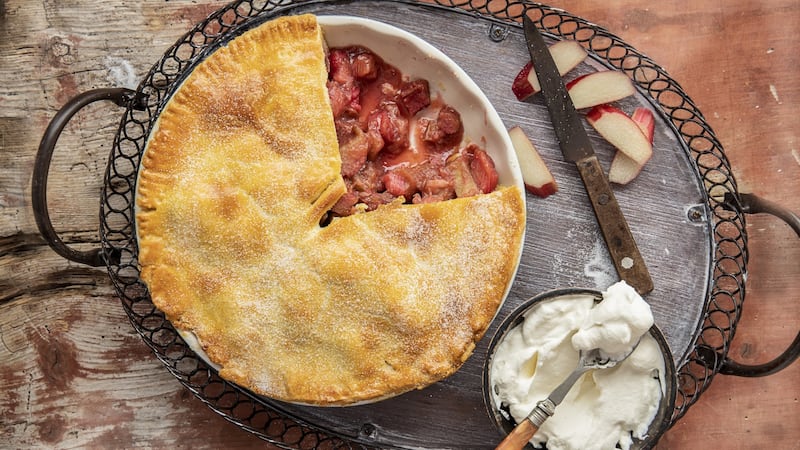Proper, golden-crusted pies are easy to bake. The trick is to find a recipe that requires a single stint in the oven rather than having to prebake the pastry base. The pies I remember from my childhood had a slightly gluey texture on the inside. I believe that was to do with the rather large amount of sugar used to balance the intense tartness of the tangy fruit.
Windfall apples precipitate pie-making rituals in autumn. Spring promises another opportunity with the appearance of electric pink young rhubarb stalks. It’s handy to have at least one nice pie dish in your kitchen, but seasoned pie-makers buy packs of aluminium dishes, which can be recycled a few times and pack neatly inside the freezer.
There is a lot of fun to be had with pastry trimmings turned into decorative letters and leaves (shamrocks are in vogue over the next few weeks!). While Bramley apples, sliced up and doused with sugar cook directly inside a pie, rhubarb releases a scary amount of liquid when treated in the same way. Some pie-makers add in cornflour to thicken the filling. I find that once I precook the rhubarb with the right amount of sugar, and remove any excess liquid, cornflour isn’t necessary.

Gently cooking rhubarb avoids it collapsing into a stringy mess. Mature rhubarb plants grown outdoors tend to be green in colour, but taste no less delicious. If you like a deep fuschia tone, buy forced rhubarb or incorporate red fruit such as strawberries into the pie filling (you can even add a little beetroot juice). The amount of rhubarb required in this recipe depends on the depth of your pie dish. Serve any remaining rhubarb or luscious syrup with yoghurt or ice cream.
RHUBARB PIE

Ingredients
Serves six
For the pastry
300g plain flour, sieved
150g chilled butter, diced small (plus extra for greasing)
60g caster sugar
1 egg, lightly whisked
For the filling
500g-750g rhubarb, trimmed and cut into 2cm pieces
150g caster sugar (plus extra for top)
Zest and juice of ½ a lemon
To glaze, 1 egg yolk
Whipped cream / ice cream, to serve
Method
Preheat oven to 180°C fan and place a baking sheet inside to heat up. Lightly grease a pie dish with a little butter.
To make the pastry by hand, place the flour into a mixing bowl. Rub in the butter until the mixture resembles breadcrumbs. Mix in the sugar. Use a knife to work in the egg, then bring together to form a dough (add a drop of water if required). Wrap the pastry and refrigerate for 20 minutes (to make pastry in a food processor, simply blitz the flour, butter and sugar to fine breadcrumbs, then work in the egg to form a dough).
While the pastry is resting put the rhubarb into a medium size heavy base saucepan with the sugar, lemon zest and juice. Cook over a medium high heat for 5 minutes, then cover and reduce the heat, cooking for another 5 minutes or so, until the rhubarb is just tender but still retains its shape. Allow to cool.
Divide the pastry into a large and small piece. Roll out the larger piece (approx 225g) and use it to line the base of the pie dish. Trim away any overhanging pastry, then brush the pastry rim with egg glaze.
Spoon the cooled rhubarb into the pie base, discarding any excess liquid. Roll out the remaining pastry to cover the filling. Trim away overhanging pastry. Seal the pastry edges together either by firmly pressing your thumb around the rim of the dish or crimp using the back of a fork. Score two slits in the centre of the pie (for the steam to escape).
Before baking, brush the entire lid with egg glaze, then lightly dredge the top with extra sugar.
Bake on the hot baking sheet in the preheated oven for 30-35 minutes or until the top is golden and the rhubarb starts to bubble up through the middle (turn the oven down if the crust is darkening). Serve warm, with ice cream or freshly whipped cream.
Variation
To slow roast rhubarb, bake rhubarb pieces with sugar, covered with a lid at 170°C fan oven for 20 minutes or until the rhubarb is just tender.


















